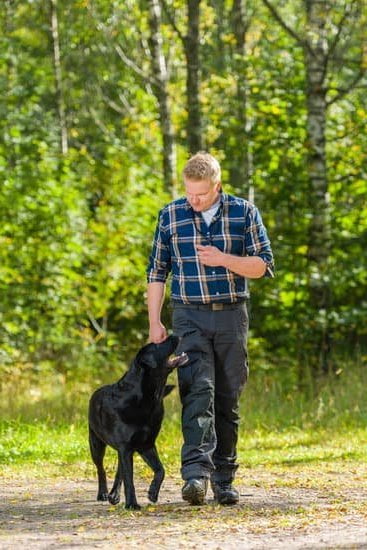Training your dog to not sleep in bed is an essential aspect of responsible pet ownership. While having your furry friend snuggle up beside you might seem comforting, it can lead to a variety of issues that can disrupt both your sleep and your dog’s well-being. In this article, we will explore the importance of training your dog to have a designated sleeping area and the potential consequences of allowing them on your bed.
Firstly, establishing a separate sleeping spot for your dog has numerous benefits. It promotes good hygiene by limiting the transfer of dirt, allergens, and pests between you and your pet. This is particularly important if anyone in your household suffers from allergies or asthma. Additionally, having their own space helps dogs establish a sense of independence and security, which contributes to their overall well-being.
Allowing your dog to sleep in bed with you can also result in sleep disturbances for both parties involved. Dogs have different natural sleeping patterns than humans, often shifting positions throughout the night or needing to relieve themselves at odd hours. Their movements can disrupt your sleep, leaving you feeling tired and groggy the next day. Training them to sleep separately ensures that both you and your four-legged companion get the restful nights you need.
By understanding these reasons behind training your dog to not sleep in bed, we can now delve into the specific steps required to achieve this goal. From creating a cozy sleeping spot for them to setting up a consistent routine and encouraging positive reinforcement techniques, this article will provide comprehensive guidance on successfully training your dog to have their own sleeping area while strengthening the bond between you both.
Understanding Your Dog’s Natural Sleeping Patterns
Dogs are known for their love of sleep, but understanding their natural sleeping patterns is essential when trying to train them not to sleep in your bed. Canines have evolved from their wild ancestors, and while they still retain some instinctual behaviors, their sleeping habits can be influenced by our domestication of them.
Natural Instincts and Sleeping Habits
Dogs are den animals by nature, which means they seek out small, enclosed spaces for rest and security. In the wild, a den would provide protection from predators and harsh weather conditions. While your bed may seem like a cozy den to your dog, it can also disrupt their natural sleeping patterns.
It is important to note that dogs are crepuscular beings, meaning they are most active during dawn and dusk. In the wild, dogs would spend the majority of the day resting or sleeping to conserve energy for hunting or scavenging during these peak activity times. However, when allowed on the bed with their owners at night, dogs may become more nocturnal in behavior due to social interaction and attention.
Influences of Allowing Dogs in Bed
Allowing your dog to sleep in bed with you can lead to several consequences that may disrupt both your sleep and theirs. Dogs tend to move around during sleep more than humans do. They may scratch themselves or shift positions frequently throughout the night, causing disruptions for both you and them.
Additionally, hygiene is a significant factor when considering whether or not to allow your dog in bed. Dogs spend time outdoors where they may come into contact with dirt, bacteria, or parasites that can easily transfer onto bedding. Regular baths and grooming can help minimize this risk; however even well-groomed dogs carry some level of unwanted elements.
By having a designated sleeping area for your dog outside of your bed, you can help provide them with a comfortable space suited to their natural instincts while also ensuring a better night’s sleep for both of you.
Establishing Boundaries
One of the crucial steps in training your dog to not sleep in bed is to establish a comfortable sleeping spot for them. Providing a designated and cozy area will not only help your dog feel secure, but it will also make the transition easier for both you and your furry friend. Here are some tips on creating an inviting sleeping spot for your dog:
- Select the right location: Choose a space that is away from your bed and any other furniture where you do not want your dog to sleep. This will help reinforce the boundary you are trying to establish. Consider a quiet corner of a room where your dog can have their privacy while still feeling connected to the family.
- Provide a suitable bed or crate: Invest in a comfortable and supportive dog bed or crate that is just the right size for your pup. The bed should be big enough for them to comfortably stretch out but cozy enough to make them feel secure. Opt for materials that are easy to clean and resistant to odors.
- Make it appealing: Spruce up their sleeping spot with familiar scents and objects they find comforting, such as their favorite blanket or toy. You can also consider adding soft lighting or soothing music nearby to create a calming atmosphere.
- Consider temperature and noise: Ensure that the location you choose is free from drafts and loud noises that may disturb your dog’s sleep. Dogs are sensitive to temperature changes, so make sure their sleeping area is neither too hot nor too cold.
Creating an inviting sleeping spot is essential in training your dog to sleep away from your bed. By providing comfort, security, and a space of their own, you are helping them understand boundaries while promoting healthy sleeping habits.
| Tips | Description |
|---|---|
| Select the right location | Choose a space away from your bed and furniture. |
| Provide a suitable bed or crate | Invest in a comfortable bed or crate that is the right size. |
| Make it appealing | Add familiar scents, toys, and create a calming atmosphere. |
| Consider temperature and noise | Avoid drafts, extreme temperatures, and loud noises near the sleeping area. |
Consistency is Key
Establishing a consistent daily routine is an essential part of training your dog to not sleep in bed. Dogs thrive on routine and predictability, so creating a structured schedule will help them understand when it’s time to sleep in their designated area. Here are some key steps you can take to establish a daily routine for your dog:
Determine Bedtime and Wake-up Time
Set specific times for your dog’s bedtime and wake-up time, ensuring that they align with your own schedule. Dogs are creatures of habit, so sticking to the same times every day will help them understand when it’s time to sleep or wake up.
Allocate Exercise Time
One important aspect of the daily routine is allocating time for exercise. A tired dog is more likely to sleep comfortably in their own bed rather than seek out yours. Plan regular walks, play sessions, or other physical activities that suit your dog’s needs. Engaging in physical exercise during the day will tire them out and create a bedtime routine where they associate sleep with exercise.
Meal Times
Incorporate scheduled meal times into your daily routine as well. By feeding your dog at consistent times, they will anticipate and rely on those meal times as part of their daily structure. This helps regulate their digestion and bathroom habits, which can contribute to a better night’s sleep.
Wind-down Period
Before bedtime, establish a wind-down period where you engage in calming activities with your dog. This could include gentle petting, brushing their fur, or practicing relaxation techniques such as massage or aromatherapy.
Throughout the entire process of establishing a daily routine, it is important to remain consistent and patient with your dog. Dogs are quick learners but need repetition and reinforcement before behaviors become ingrained habits.
By creating a consistent routine that suits both you and your dog’s needs, you are providing them with a sense of structure and predictability. This routine will help them understand when it’s time to sleep in their own bed rather than yours, leading to better-quality sleep for both of you.
In the next section, we will explore the effectiveness of positive reinforcement techniques in training dogs to sleep in their own bed and provide step-by-step instructions on how to encourage your dog to do so.
Positive Reinforcement Training
Positive reinforcement training is a highly effective method for teaching your dog to sleep in their own bed. This technique focuses on rewarding desired behaviors rather than punishing unwanted ones, which creates a positive and enjoyable experience for both you and your furry friend. By using positive reinforcement, you can encourage your dog to willingly choose their designated sleeping area, leading to restful nights and a stronger bond between you.
To begin, it’s important to select a comfortable and inviting bed for your dog. Choose one that is the appropriate size for your pet and is made of materials that they find cozy and relaxing. Place the bed in a location that is away from your own bed, creating a clear boundary for your dog. Make sure the area is quiet and free from distractions, allowing your dog to feel safe and secure.
Next, it’s time to start training. Begin by enticing your dog into their bed using treats or toys. Whenever they voluntarily enter their sleeping spot, reward them with praise and treats or playtime with their favorite toy. Repeat this process consistently, gradually increasing the amount of time they spend in their bed before receiving the reward. Soon enough, your dog will associate their bed with positive experiences and will naturally gravitate towards it when it’s time to sleep.
It’s important to practice patience during this training process as every dog learns at their own pace. Some dogs may catch on quickly while others may need more time to adjust. Stay consistent with the positive reinforcement approach and avoid getting frustrated if progress seems slow at first. With persistence and dedication from you as the owner, your dog will eventually learn to love sleeping in their own bed and enjoy many restful nights ahead.
Avoiding Negative Reinforcement
Negative reinforcement can be tempting when trying to train your dog not to sleep in bed, but it is important to avoid these methods. Using punishment-based training techniques can have negative impacts on your dog’s behavior and the overall relationship between you and your furry friend. Here are some common mistakes to avoid when training your dog:
- Physical Punishment: Avoid physically punishing your dog for sleeping in bed. This includes hitting, yelling, or any form of physical force. Not only does this create fear and anxiety in your dog, but it can also lead to aggression or other behavioral issues.
- Ignoring Your Dog’s Needs: While it is important to establish boundaries, it is equally important to meet the needs of your dog. Ignoring their needs for attention, exercise, or mental stimulation can contribute to unwanted behavior like sleeping in bed. Make sure to provide ample exercise and playtime throughout the day to tire them out before bedtime.
- Inconsistency: Consistency is key when training any behavior in dogs. If you allow your dog to sleep in bed occasionally or give mixed signals about where they should sleep, they will be confused about what is expected of them. Stick to the routine and boundaries you have established for them.
- Using Fear or Intimidation: Scaring or intimidating your dog into staying out of bed will only lead to fear and anxiety associated with their sleeping area. This can create a negative association and may exacerbate the problem rather than solve it.
Instead of using negative reinforcement techniques, focus on positive reinforcement methods that strengthen the bond between you and your furry companion while encouraging desired behavior.
By understanding why negative reinforcement should be avoided when training your dog not to sleep in bed, you will be better equipped to establish boundaries effectively without damaging the trust and relationship you have with your pet.
- Avoid physically punishing
- Don’t ignore their needs
- Stay consistent with the routine
- Avoid scaring or intimidating them
Troubleshooting
Even with the best intentions and efforts, it’s not uncommon to encounter resistance or relapses when training your dog to not sleep in bed. Dogs are creatures of habit, and breaking a habit takes time and patience. In this section, we will provide solutions for common challenges encountered during this training process and offer tips on how to maintain consistency.
- Identify the Cause of Resistance or Relapse: Understanding why your dog is resisting the new sleeping arrangement or regressing to old habits is crucial in addressing the issue effectively. Evaluate any recent changes in your dog’s routine or environment that may be causing stress or anxiety.
It could also be that your dog simply finds comfort in being close to you at night, which can be resolved by providing alternative ways for them to feel secure. - Reinforce Positive Behavior: Positive reinforcement is key in training your dog. When they choose to sleep on their own bed, reward them with treats, praise, or a special toy. By associating their designated sleeping spot with positive experiences, they will start to view it as a desirable place to rest.
- Consistency is Key: Consistency plays a vital role throughout the training process, especially when dealing with resistance or relapses. Stick to the daily routine you have established for your dog’s sleep schedule and ensure that all family members enforce these boundaries consistently. Any inconsistency can confuse your dog and make it harder for them to understand the desired behavior.
- Address Separation Anxiety: If your dog shows signs of separation anxiety when separated from you at night, gradually ease them into sleeping alone by familiarizing them with their bed during daytime naps or while you’re still present in the room. Use comforting items such as a blanket with your scent or a stuffed toy to help alleviate anxiety.
- Seek Professional Help if Needed: If despite your best efforts, you find yourself struggling with training, don’t hesitate to seek professional help. A certified dog trainer or animal behaviorist can provide expert guidance tailored to your dog’s specific needs and help you overcome any challenges you may be facing.
Remember, training takes time and patience. Each dog is unique, and the amount of time it takes for them to adjust will vary. Stay consistent, be patient, and continue reinforcing positive behavior. With perseverance, you will see progress over time and enjoy restful nights while strengthening the bond with your dog.
Patience and Persistence
Training your dog to not sleep in bed can be a challenging process that requires patience and persistence. It is important to remember that this training takes time, and every dog is unique, so what works for one may not work for another. However, with the right approach and consistency, you can successfully teach your furry friend to sleep in their own designated area.
One of the first tips for successful training is to establish a consistent routine. Dogs thrive on predictability and structure, so creating a daily schedule for feeding, exercise, playtime, and bedtime can help your dog adjust to sleeping in their own bed. Make sure to include enough exercise during the day, as a tired dog is more likely to settle down and sleep throughout the night.
Another tip is to use positive reinforcement techniques throughout the training process. Positive reinforcement involves rewarding your dog for desired behavior, such as staying in their bed or settling down calmly at bedtime. You can use treats, verbal praise, or even their favorite toy as rewards. Consistently praising and rewarding your dog when they choose to sleep in their own bed will reinforce the behavior you want to see.
It is important to avoid negative reinforcement or punishment-based methods when training your dog not to sleep in bed. Punishing or scolding your dog for getting on the bed may create fear or anxiety around bedtime, making it even more challenging to train them. Instead, focus on redirecting them to their designated sleeping spot using positive reinforcement techniques.
Remember, every dog learns at their own pace and some may take longer than others to adapt. Be patient with your furry friend and celebrate small victories along the way. With consistency, positive reinforcement, and perseverance, you can successfully train your dog to not sleep in bed and enjoy restful nights while strengthening the bond between you both.
Conclusion
In conclusion, training your dog to not sleep in bed is an important aspect of responsible pet ownership. By establishing a designated sleeping area for your dog, you can ensure both their comfort and hygiene.
Understanding your dog’s natural sleeping patterns and setting up a comfortable sleeping spot are key to successfully transitioning them to their own bed. Consistency in creating a daily routine and utilizing positive reinforcement techniques will help teach your dog to sleep in their designated area.
While training your dog, it is important to avoid negative reinforcement methods and instead focus on patience and persistence. By troubleshooting any resistance or relapses in behavior and maintaining consistency, you can overcome challenges that may arise during the training process.
By successfully training your dog to sleep in their own bed, you not only enjoy restful nights but also strengthen the bond between you and your furry friend. Having separate sleeping spaces allows for better sleep quality for both you and your dog, eliminating potential disturbances during the night. Additionally, this training establishes boundaries that help with overall discipline and obedience.
Overall, by following the tips and strategies outlined in this article, you can achieve successful training and create harmony in the sleeping arrangements within your home. Remember that building a strong bond with your dog takes time, so be patient and celebrate the small victories along the way. With dedication and consistency, you’ll soon enjoy peaceful nights of restful sleep while nurturing a loving relationship with your canine companion.
Frequently Asked Questions
How do I stop my dog from sleeping in my bed?
To stop your dog from sleeping in your bed, it’s important to establish clear boundaries and consistently reinforce them. Start by creating a comfortable and designated sleeping area for your dog, such as a cozy dog bed or crate. Encourage your dog to use this space by providing positive reinforcement like treats or praise when they sleep there.
If your dog tries to get on the bed, firmly say “no” and gently guide them back to their sleeping area. Additionally, consider creating a nighttime routine that includes activities like a short walk or play session to help tire them out before bedtime. Consistency is key, so be patient and ensure everyone in the household follows the same approach.
Should I stop letting my dog sleep in my bed?
Whether you should stop letting your dog sleep in your bed depends on personal preferences and specific circumstances. There are pros and cons to allowing dogs in bed; some people find it comforting and enjoy the close bond it can create, while others may have allergies or prefer not sharing their sleeping space with pets due to cleanliness concerns.
It’s essential to consider factors like size, behavior, hygiene habits, and how well you sleep with your dog in bed. If there are no issues with allergies or disturbances during sleep, and both you and your furry friend are happy with this arrangement, then there may not be a need to change it.
How do I get my dog to sleep alone at night?
Helping your dog learn to sleep alone at night requires patience, consistency, and gradual adjustments. Start by gradually transitioning your dog away from sleeping next to you or in your bed. Introduce a separate sleeping spot nearby using a comfortable bed or crate along with familiar bedding items or toys that have been associated with comfort before. Encourage positive associations by offering treats when they relax in their new sleeping area voluntarily.
Increase the distance between their sleeping spot and yours over time until they eventually sleep independently in another room if desired. Remember to provide ample exercise and mental stimulation during the day as tired dogs tend to settle easier at night. Most importantly, be patient and understanding throughout the process as it may take some time for your dog to adjust to the change.

Welcome to the blog! I am a professional dog trainer and have been working with dogs for many years. In this blog, I will be discussing various topics related to dog training, including tips, tricks, and advice. I hope you find this information helpful and informative. Thanks for reading!





